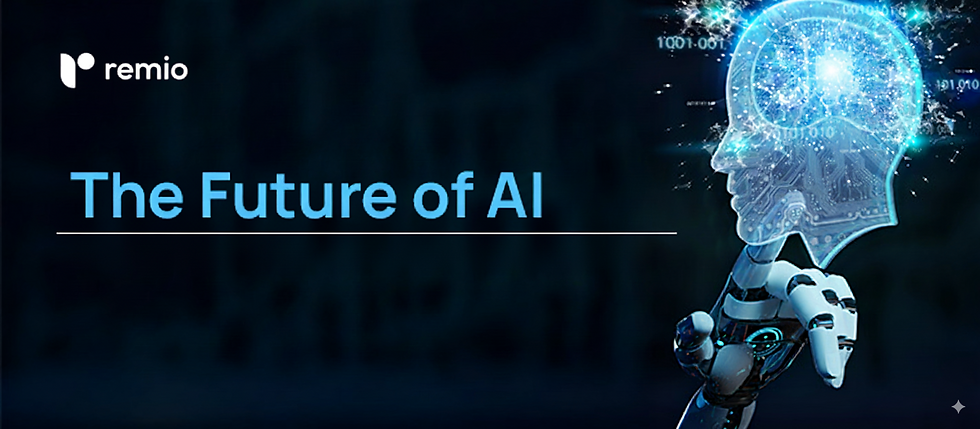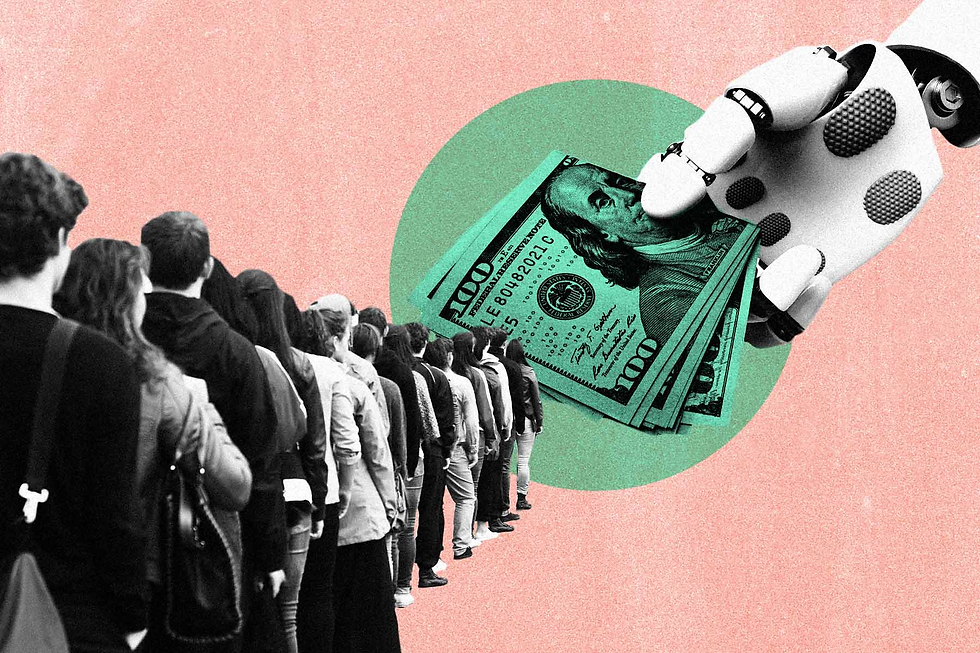Rethinking Income for the Age of AI: How the Digital Dividend Can Redefine Wealth and Work
- Ethan Carter

- Sep 29
- 7 min read

Introduction
The arrival of artificial intelligence marks one of the most profound shifts in economic and societal history. Unlike past technological leaps—from the wheel to the internet—AI advances with unprecedented speed, upending industries, jobs, and social contracts in ways few could anticipate. The question is no longer whether AI will reshape our world, but how societies can ensure this transformation benefits the many, not just the privileged few. As agentic AI systems take over more tasks, anxieties about unemployment, income disparity, and social upheaval grow louder. Yet, within this turbulence lies an opportunity: reimagining income models so all can share in AI's vast productivity gains. Central to this vision is the "digital dividend"—an innovative approach to wealth redistribution designed for the AI age.
This article delves into what it means to rethink income for the AI era, examining the digital dividend, AI's impact on labor and society, and policy measures that could drive inclusive prosperity. Whether you're an executive, policymaker, or worker navigating these changes, read on for actionable insights and a roadmap to a fairer future.
What Exactly Is Rethinking Income for the Age of AI?

Core Definition and Common Misconceptions
Rethinking income for the age of AI refers to reconsidering how wealth and earnings are distributed as artificial intelligence radically transforms the workforce and economy. Traditionally, people earned income primarily by selling their labor. With AI capable of performing knowledge and service tasks around the clock—and often at zero marginal cost—the foundation of traditional employment is at risk.
One emerging solution is the digital dividend: a structured system where the economic gains generated by AI (especially agentic AI "digital employees") are taxed or otherwise redirected, and those proceeds are shared with the human workforce, particularly those displaced or marginalized by automation. This approach is often misunderstood as simply another term for Universal Basic Income (UBI), but it specifically targets the redistribution of wealth generated by digital labor, not just broad social welfare.
Common misconceptions include:
"AI will only replace repetitive manual jobs." In fact, AI is a brain multiplier, automating complex knowledge work and decision-making at scale.
"We have plenty of time to adapt, as with past technologies." The pace of AI's rise is far faster and less forgiving, risking mass displacement without sufficient upskilling programs.
"The benefits of AI will 'trickle down' to all." Without active redistribution mechanisms, increased productivity may deepen inequality rather than alleviate it.
Why Is Rethinking Income for the Age of AI So Important?

Its Impact and Value
The urgency of rethinking income stems from the transformative, sometimes disruptive, impact of AI on global productivity and employment. Forecasts suggest that AI could add $4.4 trillion in long-term growth to the world economy, yet the distribution of these gains remains highly uneven.
Key Impacts:
Mass Job Displacement: Projections estimate up to 300 million jobs could be eliminated as AI systems automate tasks across industries.
Rising Inequality: If AI-driven wealth accrues mainly to shareholders and tech giants, economic inequality will accelerate, with millions at risk of impoverishment.
Social Cohesion: The fabric of society is threatened when large populations feel left behind by technology. Income instability often leads to increased polarization, political unrest, and erosion of trust in institutions.
Broader Prosperity: When managed wisely, AI has the power to amplify human creativity, solve systemic problems, and elevate the standard of living for all—if its rewards are widely shared.
Recognizing these stakes, over a thousand AI leaders have called for urgent policy action, including the responsible management of AI's economic fallout.
The Evolution of Rethinking Income for the Age of AI: From Past to Present
Human societies have faced technological revolutions before: the wheel, the printing press, the steam engine, and the internet all required workers to reskill and adapt. However, the AI revolution is distinct for its speed and scale. Whereas earlier transitions unfolded over generations, AI changes labor markets in years or even months.
Key Evolutionary Trends:
Brawn to Brain: The industrial revolution was a brawn multiplier, boosting manual productivity. AI, by contrast, multiplies intellectual and creative capacities.
Automation Scope: Early automation mostly affected factory and routine office jobs. Today, agentic AI can learn overnight, handle customer service, perform legal analysis, and even drive medical discoveries.
Upskilling Gaps: Historically, societies had more time to create upskilling and retraining pipelines. With AI, displacement may outpace reskilling efforts, creating a gap that new income models must address.
Redistribution Experiments: Concepts like Universal Basic Income have long been discussed, but real-world implementation remains limited. The digital dividend offers a more targeted, enforceable approach for the AI era.
How Rethinking Income for the Age of AI Works: A Step-by-Step Reveal
AI Generates Surplus Value
Agentic AI systems, capable of 24/7 work and continuous learning, produce tremendous economic value by automating tasks, improving efficiency, and enabling new kinds of innovation.
Identifying the "Digital Dividend"
A portion of AI-generated wealth is earmarked as the digital dividend. This is achieved by taxing the productivity of digital labor or establishing fee-based mechanisms for companies leveraging AI at scale.
Automated Collection and Redistribution
Governments use streamlined, possibly AI-driven, systems to track, tax, and redistribute the digital dividend, reducing bureaucratic friction and ensuring transparency.
Supporting Displaced and Augmented Workers
Proceeds are directed towards:
Income support for displaced workers
Funding universal or targeted benefits to cushion the transition
Monitoring and Adjusting
Policy mechanisms are regularly reviewed to ensure fair distribution, adapt to technological progress, and address new challenges in the workforce.
Enabling Human Flourishing
As machines take on more routine work, people can focus on creative, relational, and high-value endeavors, supported by the security of the digital dividend.
How to Apply Rethinking Income for the Age of AI in Real Life

For Policymakers:
Establish Digital Labor Taxation: Design and implement frameworks to capture value from AI-driven productivity for social benefit.
Invest in Upskilling: Expand access to training, focusing on digital, creative, and interpersonal skills less susceptible to automation.
Streamline Welfare Delivery: Leverage AI itself to automate and optimize benefit distribution, minimizing bureaucracy.
For Businesses:
Adopt Responsible AI: Factor in social consequences when deploying AI, participate in digital dividend schemes, and support transitioning workers.
Promote Human-AI Collaboration: Redesign job roles to emphasize uniquely human skills alongside digital productivity.
For Individuals:
Pursue Lifelong Learning: Continuously update skills and adapt to changing job requirements.
Engage Civically: Advocate for fair AI policies, ethical technology deployment, and inclusion in digital dividend discussions.
For Society:
Reimagine Work and Purpose: Shift cultural values from equating self-worth solely with employment to emphasizing creativity, care, and community.
Prioritize Equity: Ensure vulnerable populations are not left behind by automation's march.
Why Conscious Minds Don't Get Stuck: The Power of Time, Entropy, and Awareness
Consciousness Is Embedded in Time and Entropy
Unlike algorithms, conscious beings are "anchored in time, and in entropy". Life is a continual battle against entropy, the universal tendency toward disorder — as described by the second law of thermodynamics. Living creatures are open systems: they exchange energy with their environment, regenerating the conditions needed to stay alive.
Survival as the Ultimate Relevance Filter
Conscious experience integrates vast amounts of survival-relevant information and uses it to guide behavior — whether consciously or not. The "drive to stay alive" ensures that conscious beings continually seek novelty and solutions, rather than repeating unsuccessful actions indefinitely.
Multiscale Time Awareness
Physical, neural, and experiential processes all unfold at different temporal scales, interwoven in the stream of consciousness. This rich, multi-level engagement with time makes it almost impossible for conscious minds to be caught in true infinite loops.
Edge Cases in Human Behavior
There are rare cases—such as certain neurological injuries or disorders—where humans do fall into repetitive or "loopy" behaviors, including compulsions, Tourette's, or obsessive-compulsive disorder. But these are typically viewed as disruptions of normal conscious function, reinforcing the rule that conscious minds are naturally equipped to break out of loops.
The Future of Rethinking Income for the Age of AI: Opportunities and Challenges

Opportunities:
Shared Prosperity: Properly structured digital dividends could usher in an era of mass prosperity, with productivity gains benefiting everyone, not just a select few.
Innovation Accelerators: Freed from routine work, people may drive rapid advances in science, art, and social well-being.
Social Stability: Reducing the shock of mass unemployment through income support and reskilling may safeguard democratic institutions and social trust.
Challenges:
Policy Implementation: Global coordination is difficult; without enforceable policies, well-intentioned ideas may remain academic.
Technological Displacement Pace: As AI evolves, the scale and speed of job displacement may outstrip adaptation efforts.
Ethical Considerations: Deciding who deserves which portion of the digital dividend, and how much value should be redistributed, raises profound moral questions.
Concentration of Power: Risk remains that wealth and decision-making accrue to an ever-smaller group unless policy interventions are robust.
Conclusion: Key Takeaways on Rethinking Income for the Age of AI
AI's advance is inevitable, but whether it leaves societies fractured or flourishing depends on how we rethink income, work, and wealth distribution for the new age. The digital dividend is not just an economic proposal but a vision for an inclusive future—one where the gains of digital labor uplift all, not just the few with capital or coding skills. Proactive leadership from governments, businesses, and communities is essential to ensure that AI's tremendous gifts translate into a tide that lifts everyone.
Frequently Asked Questions (FAQ) about Rethinking Income for the Age of AI
What does it mean to rethink income for the age of AI?
Rethinking income for the age of AI means re-examining how income is distributed as AI transforms jobs and wealth creation, seeking new models like the digital dividend to ensure fairer distribution amid automation.
How could a digital dividend be implemented in practice?
A digital dividend could be implemented by taxing the productivity of AI systems, then redistributing that revenue to support displaced workers and fund social programs, with automated processes ensuring efficiency and transparency.
How does the digital dividend differ from Universal Basic Income (UBI)?
While both aim to provide financial stability, the digital dividend specifically reallocates wealth generated by digital labor, target ing those affected by AI displacement, whereas UBI offers an unconditional income to all citizens regardless of automation's impact.
What can individuals and organizations do to prepare for the age of AI?
Individuals can focus on lifelong learning and developing skills less likely to be automated, while organizations should invest in upskilling, ethical AI adoption, and support for workforce transitions.
Will AI inevitably lead to mass unemployment or is there hope for new kinds of work?
While AI will displace many roles, it also creates opportunities for new forms of human creativity and innovation. With fair policies and investment in reskilling, societies can navigate toward more inclusive and fulfilling work structures.


